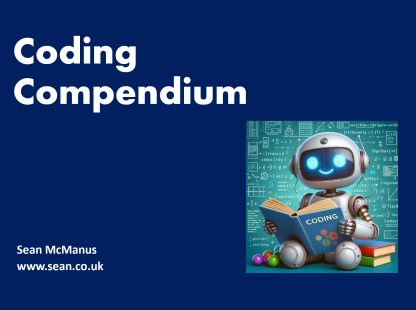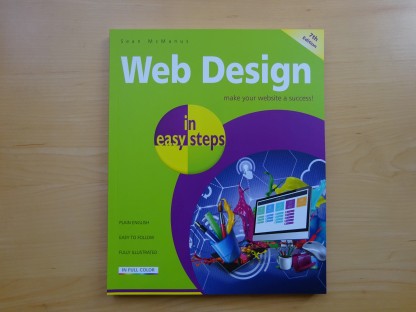
Coding Compendium
A free 100-page ebook collecting my projects and tutorials for Raspberry Pi, micro:bit, Scratch and Python. Simply join my newsletter to download it.
Internet Magazine, March 2003
You've invested days in learning to design your site and create the graphics, but how much time have you spent improving the text? Sean McManus offers some writing advice from the experts.
 "The words on a website are the most important single element on the site because the content is the reason users are visiting the site in the first place," says usability expert Jakob Nielsen. "Other elements are important too but the words carry the vast proportion of the communicative value of the web. If the content is no good, users quickly abandon a site and never return."
"The words on a website are the most important single element on the site because the content is the reason users are visiting the site in the first place," says usability expert Jakob Nielsen. "Other elements are important too but the words carry the vast proportion of the communicative value of the web. If the content is no good, users quickly abandon a site and never return."
That's a view echoed by Jennie Eley who manages website reviews for the Plain English Campaign. The campaign's mission is to banish overcomplicated writing. "As many as one in five adults in England has problems with basic literacy and numeracy," Eley says. "Writing in plain English will help to make information available to this 20% of the population."
Eley also stresses that bad writing drives readers away. "Web users have many different sources of information at their fingertips," she says. "If people can't find what they want or understand the information straight away, they will leave the site they are on and access another one."
The most common mistake is trying to look clever. "People think buzzwords, jargon and acronyms make them sound 'on the ball'," says Eley. "Often though, they sound pretentious and the text becomes meaningless. Whatever the medium they are writing for, people need to keep their language plain and their sentences short."
For many web surfers the words 'Flash', 'HTML' and even 'thumbnail' are nonsense, so don't use web jargon to direct visitors through your website. The Plain English Campaign's audit process recognises that webmasters must pay as much attention to making the navigation clear and readable as the underlying content.
People think buzzwords, jargon and acronyms make them sound 'on the ball'
Susannah Ross is the author of the book 'A Simple Guide to Writing for your Website'. She says: "With a book you can immediately see how big it is and what kind of book it is. You can be sure that the pages are organised by theme into chapters and are numbered in sequence. Using the index and thumbing through the pages at a rate of hundreds of words a second, you can find what you want quickly.
"None of this true of a website. You can't tell at a glance whether a website includes four pages or four thousand pages. You have little idea what it is about or who wrote it. You have no idea how to find your way round it until you are told. The pages are not in sequence: you may follow links from one page to another and go round in circles or out of the site altogether. Using the computer screen, you can only read a few dozen words at a time and they are hard to read because the screen has poorer definition than the printed page."
Ross advises web writers to overcome the user's disorientation and the limits of the screen by explaining themselves and their purpose clearly and repeatedly. Information, she says, should be organised into discrete sections rather than in a sequence like it might be in a brochure.
Jakob Nielsen agrees: "The very worst online content comes in the form of fat PDF files. In our tests of intranet usability, users often failed when trying to find the information they needed in hundred-page employee handbooks that had been put on the intranet as a single, unconverted PDF file. It's much better to spend the effort to convert the information into a navigable space of smaller web pages that are laid out for online reading and not for print."
Visitors skim websites and won't start reading until you catch their eye with something of interest to them, so it's important to use good text layout to make the screen easy to scan.
Paragraphs containing several similar ideas can be split into lists so their relationship can be seen at a glance. Lists can be numbered (using <OL> and </OL> around the list and <LI> before each list term) or bulleted (use <UL> and </UL> instead). "Don't make the entire page into a long bulleted list," warns Nielsen. "That's just as overwhelming. Break up the lists with connecting prose and headings."
Resist the temptation to write 'clever' headings
Use tables to lay out statistics and timetables and blockquote tags for quotations. Interested readers can access the information in them more quickly than if it's buried in a paragraph and others can skip them quickly.
Keywords in bold text or links will jump out of the screen, but this only works if they're used sparingly. Don't use underlining to attract the eye: people will think it's a link.
HTML offers up to six levels of heading, but it's best to use the top three and split complicated documents over several pages.
"Headings should be short or they change from being headlines to being prose," says Nielsen. "And despite being short, headings must be communicative and clearly denote what's covered in each section. Resist the temptation to write 'clever' headings, especially for the main title of the page which will be reused in search engines as the main way your page is represented to the searching public."
To write attractive headings, you've got to understand your reader's interests first. That's the secret to successful online copywriting, according to Brian Eisenberg. He is the co-author of 'Persuasive online copywriting: how to take your words to the bank'.
"Step two is to work out the action you want them to take," he says. "Step three - and this is where sites usually fall down - is to find out what information that person needs to take that action. The only way to convey that is through words. Every link should be an imperative with an implied benefit, for example 'click here to start saving today'."
"The internet is a participatory medium," he says. "It's not like radio, TV or a print advert. The real power to choose where to go is held by the user. If you're not answering his unspoken questions, you're going to lose him. You've got to keep resonating with his needs and wants, address his concerns and propel him to take action."
You're better off with poor writing that addresses the concerns of the reader than good writing that doesn't
His company Future Now found it could double the conversions on a job-seeking website using two words: we're hiring. It made it clear the site was recruiting directly (and wasn't an agency) and also got the message across quickly. "The reader was thinking 'I need a job, I need a job, I need a job', and when he saw 'we're hiring' we got his attention," says Eisenberg.
Although marketers often suggest using buzzwords to attract attention, Eisenberg disputes their importance. "You're better off with poor writing that addresses the concerns of the reader than good writing that doesn't," he says. "Some buzzwords do work. Everybody loves the word 'free', but only use it if it pertains to what the visitor wants and needs."
Future Now has created a customer focus calculator to check how focused a website is on the visitor's needs. "It's affectionately known as the we-we machine," says Eisenberg. "We say that people we-we all over themselves because their copy is all 'we're great, we're the best provider' and never addresses what's in it for me, the reader. It's the biggest problem across the board on every website."
Whether you're writing to sell, inform or entertain, one rule applies: start off with whatever is most important to the reader. The first paragraph needs to make clear why the story matters, or readers will skip the rest.
Newspapers use a structure known as the inverted pyramid, where the start of the story has most importance but least detail. As the story progresses, subsequent paragraphs include more information of less importance. It means that readers who don't finish the article still learn the most important facts.
If you adopt this structure, you'll be able to use the first paragraph from each story as the page's description in meta tags or on your menu page.
For longer stories, putting a summary on the end can help readers remember. The television news always does this: They tell you what they'll tell you (the headlines), they tell you it (the news) and then they tell you what they've told you (the headlines again).
Consistency is essential for credible writing. Conflicting date formats or title conventions make the text look sloppy and potentially harder to navigate. To enforce standards, magazines and websites often produce a style guide dictating their preferences where there is a choice of language and warning against common pitfalls. The Guardian publishes its style guide, which applies equally to the newspaper and website, online.
Style guide co-editor Nikki Marshall says: "We want the words we use in the Guardian to work as hard as they can, which means the language we choose must be clean, contemporary and consistent. Inconsistency is distracting and only gets in the way of what we're saying, and the style guide exists, quite simply, to help us communicate with readers. Many of its entries shape the language we use when dealing with, for example, race, gender, illness and disability, to reflect both the paper's values and the point of view of the people we're writing about. The guide also warns against common errors of grammar and fact, so if you deviate from such strictures you are usually just plain wrong."
Because it's published online, the guide can adapt to breaking news and errors can be quickly corrected. Routine updates are restricted to two or three times a year, so that journalists can be told of all the changes in one go and can easily keep up.
There's no need to write your own style guide though: you can adopt the Guardian's or another published guide.
© Sean McManus. All rights reserved.
Visit www.sean.co.uk for free chapters from Sean's coding books (including Mission Python, Scratch Programming in Easy Steps and Coder Academy) and more!

A free 100-page ebook collecting my projects and tutorials for Raspberry Pi, micro:bit, Scratch and Python. Simply join my newsletter to download it.

Web Design in Easy Steps, now in its 7th Edition, shows you how to make effective websites that work on any device.

Power up your Microsoft Excel skills with this powerful pocket-sized book of tips that will save you time and help you learn more from your spreadsheets.

This book, now fully updated for Scratch 3, will take you from the basics of the Scratch language into the depths of its more advanced features. A great way to start programming.

Code a space adventure game in this Python programming book published by No Starch Press.

Discover how to make 3D games, create mazes, build a drum machine, make a game with cartoon animals and more!